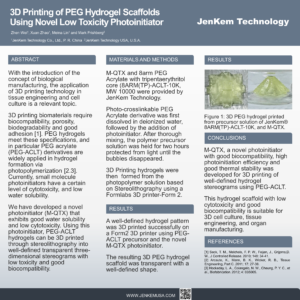| Applications of PEG Hydrogels for 2D in 3D Cell Culture and Tissue Models | |||||||||||||
JenKem Technology provides PEG derivatives for 3D bioprinting of low toxicity PEG hydrogels for 3D cell culture, tissue engineering and organ scaffolds. 
A novel low toxicity photoinitiator for 3D Printing (M-QTX) was recently launched at the 2018 SFB meeting during the poster presentation session, please contact us for details. The following excerpt from: Hutanu D, Frishberg MD, Guo L, Darie CC (2014) Recent Applications of Polyethylene Glycols (PEGs) and PEG Derivatives. Mod Chem appl 2:132. doi: 10.4172/2329-6798.1000132 features several applications of our PEG products for 3D hydrogels. |
|||||||||||||
| PEG and PEG-copolymer hydrogels are practical solutions as scaffolds and have been used and reported in 2014 publications, for cell culture; for controlled release of therapeutics; and for various other applications, including but not limited to tissue engineering.PEG hydrogels with physiologically relevant matrix elasticities and diffusion distance, fabricated in transwell inserts, were utilized by Gould et al. [38] for cell culture of valvular interstitial cells and valvular endothelial cells. Growth of the cells in the PEG hydrogel matrices has enabled relevant investigations related to aortic valve stenosis initiation and progression. As a replacement to the traditional 2D cell culture techniques for human Pluripotent Stem Cells (hPSCs), Dang et al. [42] proposed polyethylene glycol hydrogels as cell growth scaffolds, with the addition of an immobilized soluble angiopoeitin-1-derived peptide, QHREDGS. The addition of the peptide enabled a dose-dependent increase in the cell adhesion into a well-defined network, simultaneously inhibiting the apoptosis of hPSCs. The morphology of the human bone marrow stromal cells was demonstrated by Farooque et al. [40] to be closer to physiological conditions in 3D PEG tetramethacrylate hydrogels scaffolds, compared to traditional 2D planar conditions. In another application, Daniele et al. [41] developed a bio-synthetic tissue scaffold consisting of an interpenetrating network of gelatin methacrylamide polymerized within a polyethylene glycol framework for the culture of endothelial cells. This tissue model showed extensive cytoplasmic spreading and cellular adhesion, with sustained viability and proliferation for encapsulated and adherent cells. | |||||||||||||
| Lin et al. [45] developed an orthogonal thiol-ene PEG hydrogel system for cell culture of liver cell lines, Huh7 and HepG2. The hydrogel system was based on a poly(ethylene glycol)-tetra-norbornene macromere, which allowed facile incorporation of bioactive peptides (e.g., fibronectin-derived RGDS) for improved cell–matrix interactions,. According to the authors, this 3D hydrogel system is the first to upregulate the expression of NCTP in encapsulated Huh7 and HepG2 cell lines and the hepatocyte-like polarity, without genetic modification, and without the need for growth factors and chemical additives.The effect of substrate stiffness on the responsiveness of melanoma cells to treatment with a pharmacological inhibitor, PLX4032, was studied by Tokuda [43] on cell cultures on PEG hydrogel. The use of PEG hydrogels revealed stage-dependent responses to PLX4032 that were not detectable in traditional culturing techniques. For example, the researchers have demonstrated that A375 cells’ response to treatment does not depend on the stiffness of the tissue; whereas WM35 cells are more dependent on the substrate modulus, displaying increased apoptosis and decreased focal adhesions on the substrate. Zhang [49] determined that larger amounts of ammonia cross linker used in the polymerization of an 8 arm PEG macromere, lead to higher crosslinking density and bulk of hydrogels, an increased surface elasticity and, generally, to smoother surface morphologies. The amount of cross linker is therefore important in the polymerization of PEG-based hydrogels formed by amine-Michael type addition. | |||||||||||||
| For the full version of the review article published by Clarkson University and JenKem Technology USA please click visit the open source journal Modern Chemistry & Applications. | |||||||||||||
|
|||||||||||||
To learn about additional applications of JenKem Technology PEGs, please visit our website.
